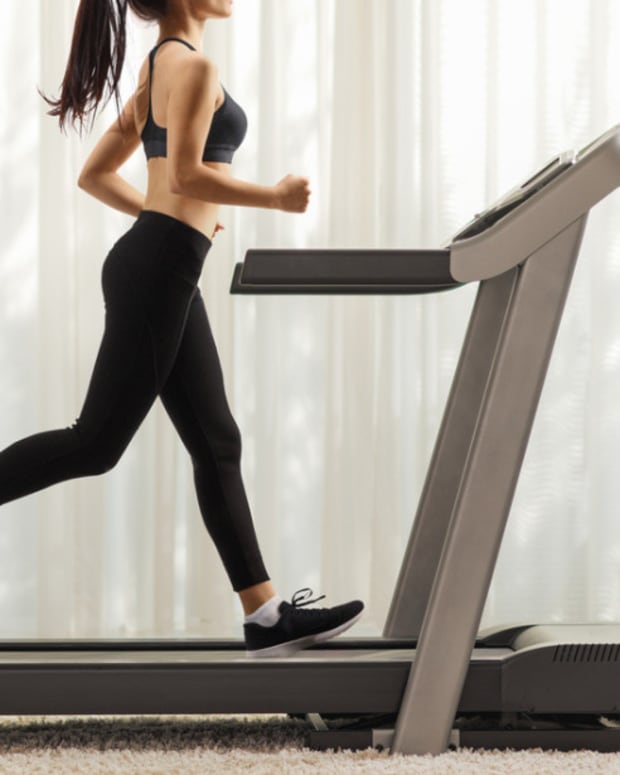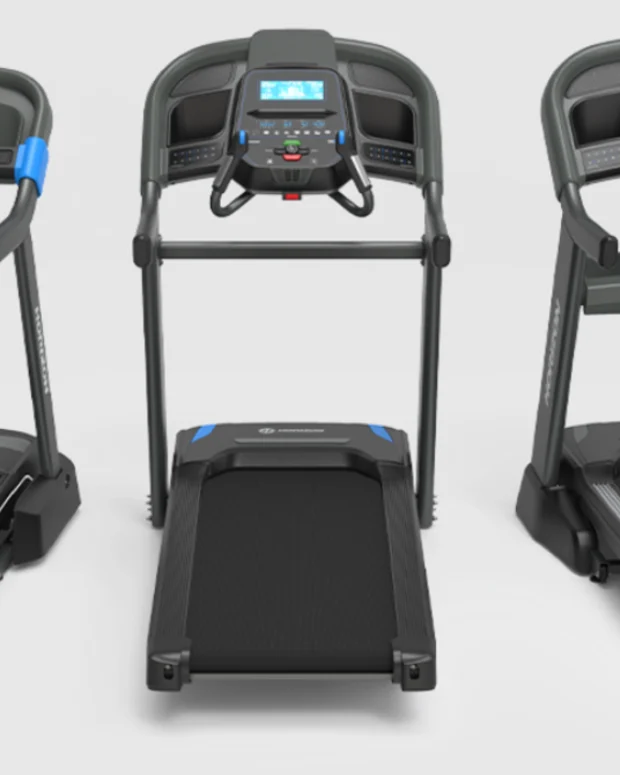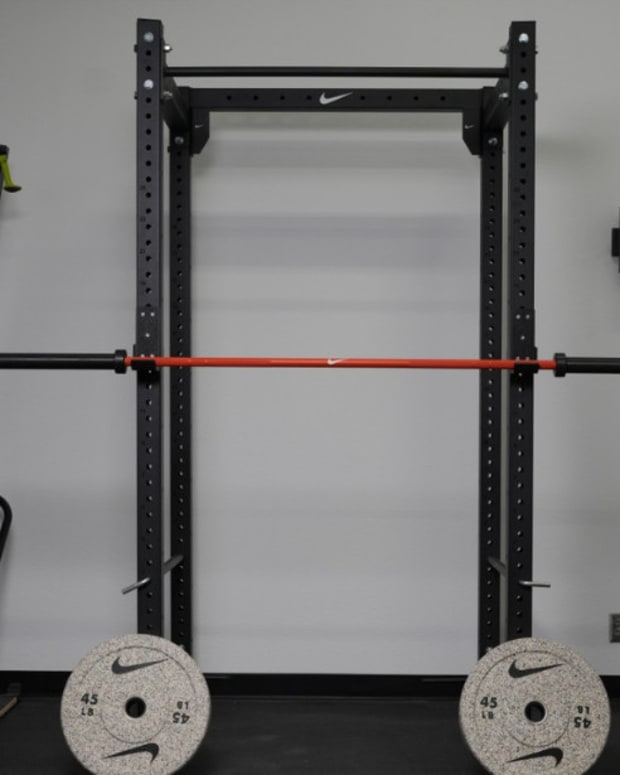The products featured in this article have been independently reviewed. When you buy something through the retail links on this page, we may earn commission at no cost to you, the reader. Sports Illustrated editorial staff are not involved in the creation of this content. Learn more here.
Treadmills are among the most popular pieces of home cardio equipment due to their versatility. With the ability to walk, jog and run on a treadmill, treadmill workouts are approachable for people of all fitness levels and fitness goals. When it comes to choosing the best treadmill for your home gym, many people gravitate toward automatic treadmills, which are the type found in most commercial gyms that require electricity and use a motor to power the treadmill. However, there are also manual treadmills, which do not require electricity and are powered solely by your own muscles as you walk or run along the treadmill belt. Interestingly, the market of manual treadmills is split, in that some of the least expensive treadmills for home gyms are manual treadmills and some of the most expensive home treadmills are manual treadmills, without many options in between.
In this article, we share our picks for the best manual treadmills for home cardio workouts, spanning the gamut of price points and features. Our comprehensive buying guide will help you choose the best manual treadmill in 2024 and learn what factors to consider when deciding whether to buy a manual vs. motorized treadmill.
Our Picks for the Best Manual Treadmills in 2024
- Best Overall Manual Treadmill: Trueform.Trainer Curved Treadmill
- Best Budget Manual Treadmill: Sunny Health & Fitness Manual Walking Treadmill
- Best Manual Treadmill for Walking: Xebex Runner Smart Connect
- Best Splurge Manual Treadmill: AssaultRunner Pro
- Best Curved Manual Treadmill: Trueform.Runner Curved Treadmill
- Best Manual Treadmill for Seniors: Sunny Health & Fitness Manual Walking Treadmill
- Best Manual Treadmill for Running: Rogue x Woodway Curve LTG Treadmill
Best Overall Manual Treadmill: Trueform.Trainer Curved Treadmill
Key Features:
- Dimensions: 64 inches by 31 inches by 63 inches
- Belt size: 64 inches by 17 inches
- Unit weight: 300 pounds
- Maximum user weight: 400 pounds
- Incline: N/A
- Key features: Steel frame; heavy-duty slatted belt
- Warranty: Ten-year frame warranty
- Price: $2,995
- Best for: People looking for a great value manual treadmill that doesn’t require electricity
Athletes in search of a curved manual treadmill that’s a great value need look no further—the Trueform.Trainer comes with solid construction and an excellent warranty at just $2,995.
It features a mild 2.5-inch curve from the highest point at the front and back of the treadmill and the low point in the center. This is one of the shallowest curves available on the market, which the brand claims will support good form at any speed. It’s also very beginner friendly because it’s easy to control how fast you’re going. The Trainer also doesn't require any electricity to run—excellent for users who may not have a power source in their home gym.
The treadmill is designed in the USA and manufactured in South Korea, with a plastic and steel frame. The frame can support users who weigh up to 400 pounds. The Trainer also has a comfortably sized belt, at 64 inches by 17 inches, which should be enough for nearly any workout and user.
We also love that Trueform offers a ten-year warranty on the Trainer—it’s one of the best available guarantees.
Pros:
- Excellent warranty
- Doesn’t require electricity to operate
- Good value
Cons:
- Low-tech
- No adjustable incline
Best Budget Manual Treadmill: Sunny Health & Fitness Walking Treadmill
Key Features:
- Dimensions: 49 inches x 23 inches x and 50 inches high
- Belt size: 42 inches long by 13 inches wide
- Unit weight: 46.7 pounds
- Maximum user weight: 220 pounds
- Incline: Fixed (not adjustable), but set at an incline of 13.5 percent
- Key features: Folds up vertically when not in use, digital monitor to display workout metrics
- Warranty: Three-year structural frame warranty and 180-day parts and labor warranty
- Price: $179.98
- Best for: Beginners looking to do low-intensity incline walking workouts
If you are on a tight budget and plan to only do walking workouts, you’ll want to check out the Sunny Health & Fitness Manual Walking Treadmill (model SF-T1407). It’s our pick for the best manual treadmill for walking. This treadmill has a fixed incline, meaning that rather than being flat, the treadmill deck is always set at a 13.5-degree incline. This is not adjustable. Incline walking offers numerous benefits over level walking, mainly in the fact that it burns more calories, elevates your heart rate more significantly for a better cardio workout and really targets the muscles of the posterior chain (glutes, hamstrings and calves). Walking up an incline can also decrease the stress on your knees, making it a great workout for anyone with chronic knee pain or other joint pain in the lower body.
Another benefit of this basic non-motorized treadmill is that it has a very compact footprint, measuring just 49 inches long by 23 inches wide when in use. We love that it can be easily folded up and rolled into a closet or from room to room depending on where and when you want to use it. It is far more portable than nearly all motorized treadmills. When it folds up, it does so nearly vertically, reducing the footprint to just 20 inches long by 28 inches wide.
However, the frame isn’t particularly sturdy and some treadmill reviews from users note that it can feel a bit flimsy or wobbly if you’re trying to walk really briskly. Because of the lightweight design construction, the maximum user capacity is only 220 pounds, so this is not the best treadmill for users who are at or above this weight. If you like to have stability afforded by holding onto the handrails, you will enjoy that the ones on this treadmill are coated in a soft foam for improved grip and comfort. Another perk is that there is a basic LCD console that displays workout metrics such as your time, distance, speed and calories burned.
Pros:
- Inexpensive and compact treadmill makes it a great entry-level cardio machine for home workouts
- Incline increases the difficulty of the workout
- LCD console displays workout metrics
- Lightweight design and wheels makes it easy stow when not in use
Cons:
- Low maximum user weight limit and small belt size makes it unsuitable for larger users
- Incline is not adjustable
- Can’t really run on it due to the small size and lightweight construction
Best Smart Manual Treadmill: Xebex Runner Smart Connect
Key Features:
- Dimensions: 71 inches x 35 inches x 60 inches
- Belt size: 67 inches long by 17 inches wide
- Unit weight: 332 pounds
- Maximum user weight: 350 pounds for running and 700 pounds for walking up to four miles per hour
- Incline: None, but there is a curved running deck
- Key features: Connects to Bluetooth and ANT+ headphones and chest strap heart rate monitors, high-contrast digital monitor to display workout metrics, numerous built-in workout programs, console is compatible with iOs Apple and Android fitness apps
- Warranty: Five-year frame warranty, three year warranty on moving parts and two-year console warranty
- Price: $3,295
- Best for: Serious runners looking for a motorless treadmill that has many of the technological and performance features of premium commercial-grade treadmills
The Xebex Runner is a premium non-motorized, curved treadmill. Like other manual treadmills, power for the Xebex Runner is self-generated, but the company reports that the treadmill is specifically designed to have the largest "sweet-spot" and maximum responsiveness to your walking and running speeds. The "sweet-spot" refers to the areas on the treadmill where your feet land when you are trying to maintain, increase or decrease your running speed. The larger this surface area, the easier it will be for you to hit the exact pace you are looking for, whether you are trying to maintain steady effort during a long run, accelerate into a sprinting interval or even slow down for a recovery.
The Xebex Runner features a 10-millimeter thick, low-impact, shock-absorbing, vulcanized rubber treadmill running surface that is constructed from the same material as competitive running tracks to reduce joint stress on the hips and knees, absorb shock and best replicate an ideal running surface.
Unlike most non-motorized treadmills, which feature only very rudimentary LCD monitors with basic workout metrics, the Xebex Runner has a Smart Connect Console. This console is compatible with a variety of treadmill apps as well as group leaderboard software so that you can use your smartphone or tablet while running on the Xebex Runner for a more interactive workout and advanced performance tracking. The built-in console also displays basic stats like your time, distance, calories burned, speed, watts (power), pace and steps per minute. There are also heart rate and interval programs to help you stay on track with your fitness goals.
Another feature we love on the Xebex Runner is that there’s a resistance knob that allows you to increase or decrease the tension on the belt for forward movement. This not only can make your walking and treadmill running workouts more challenging, but it also enables you to walk backwards while facing forwards on the machine, which can burn more calories, target different muscle groups and reduce joint stress.
The Xebex Runner has a solid steel frame construction so that it feels sturdy and stable, even when sprinting at high speeds. The slatted belt is said to be precision-balanced and the drive system features premium ball bearings not only for smooth movement, but also to prevent the need for lots of maintenance. The running deck is also much longer than most home treadmills, yet the footprint is more compact. That’s why we think it’s a great treadmill for runners who have limited space, but don’t want to compromise on the size of the running belt. Budget home treadmills with a shorter belt (less than 55 inches or so) can be limiting for taller runners or those with a long stride.
Related Post: The Best Commercial Treadmills
The console displays workout metrics like time, heart rate, speed, distance, watts, calories, pace and steps per minute. There are also more advanced functions and workout programs like intervals, pace, target distance or time, target calorie burn and others. If you set a target pace, for example, the machine will prompt you if you need to speed up or slow down to help you stay on track to reach your goals. The console also keeps track of your workout history and stats like the max speed you’ve ever hit.
Pros:
- Solid steel frame and handrails makes the unit very stable
- Thick, shock-absorbing, vulcanized rubber running surface provides cushioning to decrease joint stress
- Higher maximum user weight capacity and larger belt size compared with budget manual treadmills
- Very positive user ratings and reviews
- Ability to adjust resistance on the belt allows you to walk backwards while facing forwards
- Built-in workout programs to help you stay on motivated
- Easy assembly
Cons:
- Expensive
- Warranty could be better for the price point
- No incline
Best Splurge Manual Treadmill: AssaultRunner Pro
Key Features:
- Dimensions: 69.9 inches x 31.7 inches x 64.4 inches
- Belt size: 62 inches long by 17 inches wide
- Unit weight: 298.2 pounds
- Maximum user weight: 350 pounds
- Incline: None, but there is a curved running deck
- Key features: Connects to Bluetooth and ANT+, high-contrast digital monitor to display workout metrics and numerous built-in workout programs
- Warranty: Seven-year frame warranty and three year warranty on moving parts
- Price: $2,999
- Best for: Serious runners looking for a treadmill that supports a natural running stride
The AssaultRunner Pro is a top-of-line non-motorized curved belt running treadmill made by Assault Fitness, a company known for premium self-powered cardio exercise equipment. Like other self-powered treadmills, you have to stay present in your workout rather than zone out as you might when running on a regular commercial gym treadmill.
The AssaultRunner Pro has some built-in onboard programs to set a target time, calories, distance, speed, watts, pace and heart rate. There is Bluetooth and ANT+ connectivity for chest strap heart rate monitors.
User reviews note that the compact footprint, responsiveness and easy-to-read console display are among the top benefits of the AssaultRunner Pro. Plus, there is an excellent warranty, which speaks to the quality and durability of the machine. In addition to having a durable steel frame, all of the hardware is corrosion resistant and there are 100 ball bearings along the slatted tread belt for smooth, balanced and steady rotation as you run. The belt is guaranteed to last for 150,000 miles of training, giving you a reliable and long lasting training “partner“ as you work toward goals, whether you are trying to finish your first 5K, take on an ultramarathon or lose weight.
Pros:
- Solid steel frame and handrails for added stability and corrosion-resistant hardware for durability
- Belt lifetime of 150,000 miles
- Higher maximum user weight capacity and larger belt size compared with budget manual treadmills
- Very positive user ratings and reviews
- Larger belt size is ideal for runners of all sizes and stride lengths
- Built-in workout programs to help you stay on motivated
- Easy assembly
Cons:
- Expensive
- Some user reviews note that it takes a little bit of time to get used to the feeling of running on the curved manual treadmill
- No incline
Best Curved Manual Treadmill: Trueform.Runner Curved Treadmill
Key Features:
- Dimensions: 64 inches x 31 inches x 63 inches
- Belt size: 64 inches x 17 inches
- Unit weight: 350 pounds
- Maximum user weight: 700 pounds
- Incline: None, but there is a curved running deck
- Key features: Curved belt, steel frame, made in the USA
- Warranty: 20 years on frame
- Price: $6,149
- Best for: Serious runners looking for a treadmill that supports a natural running stride
For users seeking a classic curved manual treadmill experience, we recommend the Trueform.Runner. This motorless treadmill is completely self-powered—the user controls the speed and acceleration entirely. The running surface is shaped in a shallow, symmetrical curve, with the higher points at the front and back of the machine. The brand says that this is designed to provide a tougher running experience than a flat running surface, which results in better performance in your chosen sport. The shape also provides little to no artificial help in moving the belt, while helping the user maintain control. According to the brand’s website, you’ll burn 43 percent more calories on a Trueform.Runner than you will while running on a standard flat treadmill.
In addition to that increased intensity, one of the Trueform’s greatest strengths is its super-sturdy steel construction: It’s able to support runners that weigh up to 700 pounds—far more than any other model on this list. That durability is reflected in the brand’s mega 20-year warranty on the frame.
It’s made in the USA, too, and we like that Trueform offers the option to customize the treadmill’s colors (a $500 upcharge).
Pros:
- Built in the USA
- Can support users up to 700 pounds
- Excellent warranty
Cons:
- Very expensive
- Additional difficulty may be a drawback for some
Best Manual Treadmill for Seniors: Sunny Health & Fitness Walking Treadmill SF-T1407
Key Features:
- Dimensions: 49 inches x 23 inches x 50 inches
- Belt size: 42 inches x 13 inches
- Unit weight: 46.7 pounds
- Maximum user weight: 220 pounds
- Incline: Fixed (not adjustable), but set at an incline of 13.5 percent
- Key features: Folds up vertically when not in use, digital monitor to display workout metrics
- Warranty: Three-year structural frame warranty and 180-day parts and labor warranty
- Price: $179.98
- Best for: Seniors and other people looking for a simple machine for low-intensity incline walking workouts
Seniors who are interested in a motorless treadmill should check out the Sunny Health & Fitness Walking Treadmill SF-T1407—it’s a great choice for anyone who wants to complete low-intensity walking workouts on a machine that’s not too complicated.
The SF-T1407 is a self-powered treadmill, so there’s no electricity required, and no apps or tablets needed to track your stats. A digital monitor on the center of the handles tracks time, distance, speed and calories, and soft non-slip handles provide a place to hold onto. The treadmill has a fixed 13.5-percent incline, which ups the difficulty of the movement, and also helps the belt start moving as you walk. It also folds vertically to save space when not in use.
However, be aware: Multiple reviewers on the Sunny Health & Fitness website say that the incline of this treadmill makes it so that you need to hold on to the handles while walking; this may make it difficult for some people with balance issues to use safely.
Pros:
- Inexpensive
- No electricity required
Cons:
- Incline is not adjustable
Best Manual Treadmill for Running: Rogue x Woodway Curve LTG Treadmill
Key Features:
- Dimensions: 67 inches x34 inches x 70 inches
- Belt size: 62 inches x 17 inches
- Unit weight: 297 pounds
- Maximum user weight: 350 pounds
- Incline: None, but there is a curved running deck
- Key features: Connects to Bluetooth and ANT+, LCD display
- Warranty: Info not available
- Price: $3,995
- Best for: Serious runners looking for a treadmill that supports a natural running stride
With its ergonomic curved deck and cushy, slatted belt, the Rogue x Woodway Curve LTG Treadmill is a great choice for knocking out tough running workouts. This self-powered treadmill is fully manual, meaning that there’s no motor and no electricity required. The speed of the belt is controlled directly by the user’s stride, making it totally customized to every runner.
The brand claims that the Curve LTG’s design puts less stress on muscles, joints and tendons, which can be helpful for runners who are prone to repetitive stress injuries. The LCD display tracks a range of metrics, including speed, time, calories and watts. It’s also able to track your heart rate, when paired via Bluetooth or ANT+ with a heart rate monitor.
Check out our Woodway treadmills review for more information on Woodway's variety of treadmills.
Pros:
- Designed to exert less strain on muscles and joints
Cons:
- Expensive
What Is a Manual Treadmill?
A manual treadmill is a piece of stationary cardio exercise equipment. Users walk on a belt that’s situated on rollers, which allow it to move freely at the desired speed. Manual treadmills are unique from other varieties in that they do not have motors; rather, the belt is moved entirely by the user’s muscles. There are a few different types of manual treadmills.
Curved manual treadmill
This type of manual treadmill has a curved walking surface, with the high points being at the front and back of the treadmill and the lowest point in the middle. This helps users get the momentum needed to power the treadmill. The belts on curved manual treadmills are often made of slats.
Hybrid manual treadmill
A hybrid manual treadmill offers both motorized and non-motorized workouts. These treadmills have a motor, and can be used like any traditional powered treadmill. However, they also offer the option to turn the motor off, and power the treadmill with the user’s own strength. This is typically a different experience than a curved manual treadmill—the user doesn’t have the benefit of gravity to help move the belt along, which means it can be more difficult to use. Also, a hybrid treadmill often still needs to be plugged in when being used in manual mode, in order to track the distance traveled and speed.
However, this setup does allow for flexibility and options—if your household has multiple treadmill users with different workout goals, a hybrid treadmill can be an excellent choice.
Flat belt manual treadmill
A flat belt manual treadmill is fairly self-explanatory—rather than having a curved walking surface, it uses a flat belt. The front of the treadmill is generally inclined, in order to help the user benefit from gravity as they move the belt. These treadmills have no motor, so all of the work is done by the user. These treadmills are the most basic kind, and usually cost the least.
The Difference Between Manual and Motorized Treadmills
Although many people assume that a motorized or electric treadmill is automatically going to be “better” than a manual treadmill, that is not always necessarily true. There are plenty of people who find that manual treadmills are more suitable than motorized treadmills for their needs.
The main difference between a manual treadmill and a motorized treadmill is the type of power source required to operate the machine. With a motorized treadmill, the machine is plugged into a power outlet because the motor requires electrical power. On the other hand, a manual treadmill does not need to be plugged in. It operates under your own power; your own body is the engine or motor. Moreover, to adjust the speed on an electric treadmill, you press a button and the motor spins faster, rotating the running belt faster. There’s a finite interval between each possible speed (usually 0.1 miles per hour) and there is always a maximum speed. For example, most budget motorized treadmills max out at 3.7 miles per hour whereas most mid-range motorized treadmills for home gyms can reach speeds of 10 or 12 miles per hour and premium units can go even faster. In contrast, when using a manual treadmill, the speed is completely controlled by your effort; the faster you move on the belt, the faster it will go. There is no maximum speed and no defined gradations between different speed “options.” You are in control.
With that said, it can be challenging to maintain a consistent speed on a manual treadmill because you must stay more mindful and present during your workout to keep the belt moving. With a motorized treadmill, you can essentially “set and forget,“ meaning that you simply have to keep up with the belt as it moves along once you select your speed.
The Benefits of Manual Treadmills
One of the benefits of using a manual treadmill is that it is theoretically harder in terms of the muscular demand and potentially even the potential cardio intensity. Rather than having to just keep up on a moving treadmill belt, you have to exert your own energy to push your feet against the deck of the manual treadmill to propel it forward. Ultimately, this means that on a manual treadmill, you can elevate your heart rate into higher-intensity zones at slower speeds giving you a great cardio workout.
Research has shown that the number of calories burned during a manual treadmill workout is up to 30 percent higher compared with using an electric treadmill at the same speed. Curved manual treadmills are particularly great for high-intensity interval training (HIIT) workouts and boosting cardiovascular fitness.
Another benefit of buying a manual treadmill rather than a motorized one is that a manual treadmill does not require access to an outlet for power. Therefore, you can place a manual treadmill anywhere in your home and you won’t have an increase in your electricity bill. They also tend to be lighter and easier to move around because there are no heavy electronic components within the unit.
How to Choose the Best Manual Treadmill for You
There are several important factors to consider when choosing the best non-motorized treadmill for your home:
Design
Manual treadmills will have either a flat belt or a curved belt. Flat belt treadmills are cheaper and most people are more familiar with this design. These treadmills are designed primarily for walking and feature an incline on the running deck to aid in your ability to self-propel the belt forward. Curved treadmills have a concave design. Rather than having a smooth, continuous running belt like standard treadmills found in the gym, most curved non-motorized treadmills for running have a running belt that is made from slats that are each about one to three inches in width.
A curved manual treadmill is designed to facilitate high-intensity sprinting, faster running or longer running workouts. Although there is limited research to substantiate the claims, the thought is that the curved design helps optimize the biomechanics of running and reduce stress on your joints. If you are a serious runner and plan to use your manual treadmill for dedicated running training, choosing a curved treadmill is a better option than a flat manual treadmill. However, keep in mind that the price difference between the two types of manual treadmills is significant, and it’s rare to find a curved manual treadmill for much less than $2,000.
Incline
The cheapest manual treadmills do not have the ability to adjust the incline of the machine. However, some more expensive manual treadmills allow you to manually raise the running deck. Although you cannot adjust the incline automatically or during your workout in the way that you can on a motorized treadmill, having the option to physically adjust the incline is certainly a benefit because it increases the versatility and functionality of your manual treadmill.
Additional features
Basic budget-friendly manual treadmills are little more than a frame with a running deck and belt. This can be suitable for those who need just a bare bones piece of fitness equipment for cardio workouts. However, if you’re used to using commercial-grade treadmills at the gym, you’ll probably be very underwhelmed by the features of the machine. Many people find it beneficial to spend just a little more money for features such as foldable frame to reduce the footprint of the machine when not in use, pulse sensors in the handrails for heart rate monitoring and a built-in tablet holder. Most of the best manual treadmills have a battery-operated console with an LCD display, which tracks your workout metrics such as your total time, distance and speed. Higher-end manual treadmills that have pulse sensors in the handrails also display your heart rate and calories burned.
Price
The price range of manual treadmills is vast, with low-end, budget manual treadmills with a flat belt costing as little as $200 or less, whereas the high-end premium manual treadmills with a curved belt can cost upwards of $2,000. Unlike electric treadmills, which can be found at all price points in this range, there aren’t many options for mid-range manual treadmills, so your budget will really determine the features of the machine you can get.
How to Use a Manual Treadmill
Using a manual treadmill is as simple as it gets when it comes to home exercise equipment. All you have to do is get on the machine and start walking, jogging or running. As your feet push off on the treadmill, the running belt will rotate propelled by your own power. Some manual treadmills have a manual incline adjustment, which means that before you get on the machine, you can raise the front part of the running deck and lock it in place. This will enable you to walk or run up an incline during your workout, increasing the intensity, calories burned and workload on the muscle groups such as your glutes, hamstrings and calves.
Manual Treadmill FAQs
Are manual treadmills good for seniors?
Manual treadmills are generally not recommended for seniors because they can be harder to operate and flat belt manual treadmills always have incline pitch, so they cannot be used for flat walking. However, fitter and more agile seniors might enjoy the challenge and simplicity of operating a manual treadmill. Plus, one of the benefits of a manual treadmill versus a motorized one is that a belt only moves forward under your own power, so you are always in complete control of the speed at which you are moving. Additionally, if you fall off or stop suddenly, the belt will immediately stop moving because you are no longer powering it. In contrast, a motorized treadmill will continue running unless the safety switch is triggered.
Is it hard to walk on a manual treadmill?
It is harder to walk on a manual treadmill than an electric treadmill because all of the power required to propel the running belt forward is generated by your own muscles. You will need to engage the muscles of your lower body such as your quads, hamstrings, glutes and calves more, even at slower speeds and lower workout intensities than when using an electric treadmill.
Does a manual treadmill burn more calories?
Studies suggest that manual treadmills burn more calories per minute than motorized treadmills when you are moving at the same speed. This increased energy expenditure is due to the fact that you are having to engage your muscles and work harder to provide the necessary power to walk or run on a manual treadmill, whereas the electric motor is doing some of that work for you on a motorized treadmill.
How fast can you run on a manual treadmill?
Unlike motorized treadmills, which have a maximum speed at which the motor will move the running belt, there is no limit to how fast you can run or walk on a manual treadmill. The maximum speed is solely determined by your own fitness level and strength. The faster you run or walk, the faster the belt will move.
Final Thoughts
Although both manual and motorized treadmills can be used for running and walking and each have their distinct advantages, buying a manual treadmill for your home gym can be a great option for those who have a limited budget, limited space or who want to maximize the potential intensity of your cardio treadmill workouts. Choosing the best manual treadmill for your needs involves considering your budget, space limitation, fitness level, types of workouts you plan to do and features that are most important to you.
Prices are accurate and items in stock as of publish time.
















